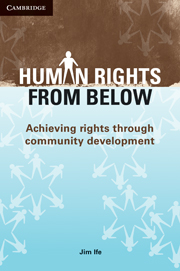Book contents
- Frontmatter
- Contents
- Acknowledgements
- Introduction
- Part 1 Thinking about community development
- Part 2 Thinking about human rights
- Part 3 Bringing human rights and community development together
- 5 Principles of human rights from below
- Part 4 Enacting human rights from below
- Appendix: The human rights matrix
- References
- Index
5 - Principles of human rights from below
Published online by Cambridge University Press: 05 June 2012
- Frontmatter
- Contents
- Acknowledgements
- Introduction
- Part 1 Thinking about community development
- Part 2 Thinking about human rights
- Part 3 Bringing human rights and community development together
- 5 Principles of human rights from below
- Part 4 Enacting human rights from below
- Appendix: The human rights matrix
- References
- Index
Summary
CONTRIBUTIONS OF EACH TO THE OTHER
In this section, we will examine the potential contributions that community development and human rights can make to each other, both theoretically and in terms of practice.
Both human rights and community development are powerful ideals and, in the forms developed in previous chapters, each has the potential to make significant contributions to progressive politics and to movements for social change. However, this does not necessarily happen. Both community development and human rights can be constructed in ways that are more conservative and indeed reactionary. Community development can readily become a discourse of exclusion, of border protection, used to pursue racist, sexist or homophobic ends. Similarly, approaches to human rights can be developed in ways that reinforce an individual's right to dominate others, including the right to manage, the right to bear arms, the right to own media and manipulate public opinion, the right to express views that insult the dignity of others or the right to earn excessive salaries while others remain poor.
It must therefore be emphasised that, in the discussion that follows in this and later chapters, the terms human rights and community development are used specifically in the ways outlined in previous chapters and not in other ways that may be adopted by various media and other commentators. Each is a complex and contested idea requiring nuanced understanding, and each contains political/ideological implications that need to be identified and articulated.
- Type
- Chapter
- Information
- Human Rights from BelowAchieving Rights through Community Development, pp. 123 - 154Publisher: Cambridge University PressPrint publication year: 2009



